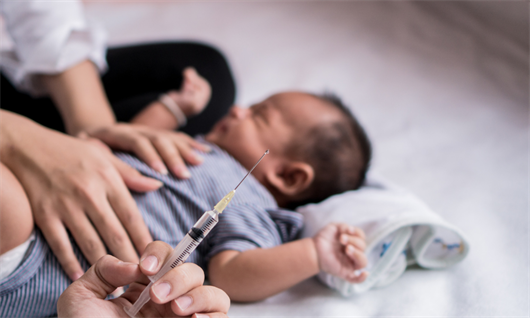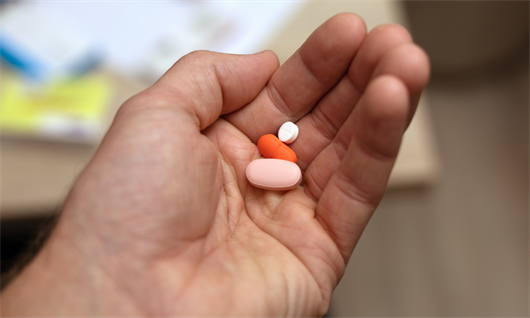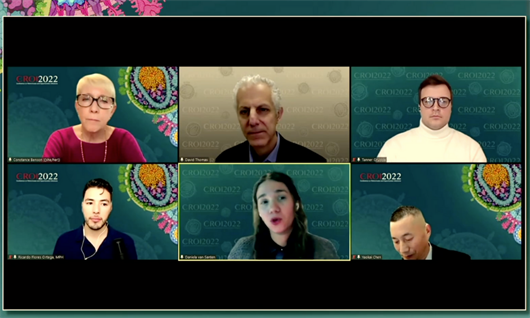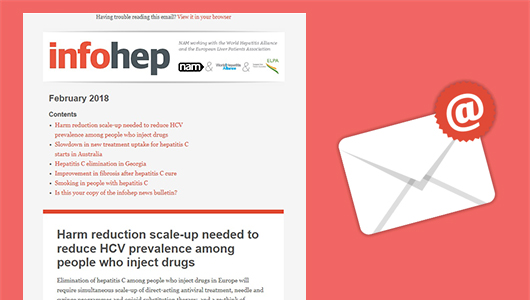Having trouble reading this email? View it in your browser
| |
February 2022 | |
Immunoglobulin-free strategy highly effective for prevention of mother-to-child hepatitis B transmission in Cambodia
Peeradon payakpan/Shutterstock.com A hepatitis B immunuglobulin-free strategy for prevention of mother-to-child hepatitis B transmission is feasible and highly effective in a resource-limited setting if tenofovir is given for at least four weeks prior to delivery, a team of French and Cambodian researchers reported earlier this month at the Conference on Retroviruses and Opportunistic Infections (CROI 2022). Reducing mother-to-child transmission of hepatitis B is a critical element in efforts to eliminate hepatitis B. Perinatal prophylaxis against mother-to-child transmission of hepatitis B consists of infant vaccination against hepatitis B within 24 hours of birth, along with infusions of hepatitis B immunoglobulin G (HBIgG) for the infant after birth, to provide antibody protection until the infant’s own response begins to produce antibodies after vaccination. For mothers, tenofovir treatment during the last trimester of pregnancy is recommended if the hepatitis B DNA level is above 5.3 log 10 IU/ml, and/or the mother is hepatitis B ‘e’ antigen positive (HBeAg+) (a sign of viral replication). But for lower-income countries like Cambodia, this strategy can be challenging to implement due to limited health system resources. Lack of access to HBIgG and HBV DNA testing prevents timely provision of either HBIgG or tenofovir. Immunoglobulin-free alternative regimens are needed, as well as a point-of-care rapid test for hepatitis B ‘e’ antigen as an alternative to HBV DNA quantification. The TA-PROHM study was designed to test a strategy that could address these gaps. Pregnant women were tested for hepatitis B ‘e’ antigen, offered tenofovir treatment from week 24 of pregnancy if they tested positive or had an ALT measurement above 40 IU/ml, and infants received a three-dose hepatitis B vaccine dose after delivery. The study findings showed that the combined intervention of rapid testing for hepatitis B ‘e’ antigen, tenofovir treatment for mothers initiated at least four weeks prior to delivery and infant hepatitis B vaccination prevented mother-to-child transmission of hepatitis B. All infants who tested positive for hepatitis B surface antigen were born to mothers who initiated tenofovir less than four weeks prior to delivery. Related linksUniversal hepatitis C screening in pregnancy improves case detection
Anastasiia Chepinska/Unsplash Implementing universal testing for hepatitis C during pregnancy improved case detection 7.5-fold compared to the previous regime of risk-based screening, a research group from the University of Pittsburgh reported at the Conference on Retroviruses and Opportunistic Infections (CROI 2022). Hepatitis C prevalence among pregnant women in western Pennsylvania doubled between 2006 and 2016, from approximately 1% to over 2%. Increased prevalence of hepatitis C among pregnant women in Pennsylvania is a consequence of the opioid epidemic, said Dr Catherine Chappell of the University of Pittsburgh. University of Pittsburgh Medical Center began to implement universal screening for hepatitis C during pregnancy in June 2020. Dr Chappell presented a comparison of hepatitis C screening and case detection during periods of risk-based and universal screening in western Pennsylvania. The risk-based screening period chosen for analysis was 2019; the universal screening period ran from 1 July 2020 to 30 June 2021. During the risk-based screening period, 12,142 women entered prenatal care. The study population was 19% Black, 72% White and 2% Hispanic. Just under half (46%) were covered by Medicare or Medicaid health insurance. During the universal screening period, 12,558 women entered care. Seventeen per cent were Black, 74% White and 2% Hispanic. Forty-five per cent had Medicare or Medicaid insurance. Screening rates increased from 21% during risk-based screening to 81% during universal screening. The rate of confirmatory HCV RNA test also increased, from 22% to 95%, as a consequence of the use of reflex testing (automatically performing an HCV RNA test on any sample that has shown a positive HCV antibody result). During the risk-based screening period, eleven women were diagnosed with chronic hepatitis, a prevalence of 0.091%. During the universal screening period, 85 women were diagnosed with chronic hepatitis C, a prevalence of 0.68%. It wasn’t possible to link to infant health records in this study. Therefore, the researchers estimated the number of infant hepatitis C cases based on a published historical mother-to-child transmission rate of 5.8%. Among 85 HCV-positive mothers, this would mean an estimated total of five children might also have been infected. They estimate that one infant with hepatitis C would have been identified as a result of risk-based screening of mothers, compared with five as a consequence of universal screening. “Universal screening resulted in a 7.5-fold increase in the detection of chronic hepatitis C,” Dr Chappell concluded. Related linksAntihistamine use halved the risk of liver cancer in people with viral hepatitis
Alina Kuptsova/Pixabay Antihistamines used for relief of allergies and hay fever halved the risk of developing hepatocellular carcinoma (liver cancer) in people with viral hepatitis during a ten-year follow-up period, a review of people with viral hepatitis in Taiwan has concluded. The findings, published in the Journal of Clinical Oncology, showed that greater use of H-1 antihistamines – the type used for allergy relief – reduced the risk of liver cancer by 60% in people with hepatitis B who used them on at least 120 days in the follow-up period. People with hepatitis B who took fewer antihistamine doses had a smaller reduction in risk, although those with the lowest exposure (28-42 daily doses) still had a 40% reduction in the risk of liver cancer. Similar dose-response relationships were seen in people with hepatitis C and in people with both hepatitis B and C. The study looked at liver cancer rates in 521,071 people with hepatitis B, 169,159 people with hepatitis C and 39,016 people with both viruses who received health care in Taiwan between 2006 and 2015. The Taiwanese research group say that their findings suggest that further research is needed to understand the mechanism by which H1-antihistamines might reduce the risk of hepatocellular carcinoma and to clarify whether they could serve as an adjuvant treatment. The current observations were made in a retrospective cohort. In the future, controlled prospective cohort studies could provide more reliable data on the impact of antihistamines on the risk of liver cancer. Related linksHepatitis C treatment and cure targets for people living with HIV still not being met in Europe
Olya Maximenko/Shutterstock.com While over 90% of people living with HIV in Europe have been tested for hepatitis C, diagnosis remains suboptimal in the east of the continent. In three out of five European regions, fewer than 80% of people with HIV and hepatitis C co-infection have received hepatitis treatment and the proportion who have been cured does not exceed 80% in any region. The study published in the March issue of AIDS also shows that there are significant differences between countries. The study looked at hepatitis C testing, engagement in care, treatment and cure in people living with HIV in the EuroSIDA cohort, up to October 2019. The study found that 20,437 (91%) EuroSIDA participants had ever been tested for hepatitis C antibodies, of whom 9103 (41%) had antibodies. Among those, 4773 (52%) were in care in 2019. Compared to 2015, when direct-acting antiviral treatment was not broadly available in Europe, hepatitis C testing has increased from 81% to 93% and current infection has fallen from 62% to 19%. Access to treatment has increased from 44% to 73%, while the proportion cured has jumped from 16% to 56%. Related linksNew cases of hepatitis C declining in people with HIV as access to treatment broadens
Dr Daniela Van Santen (bottom row, centre) at CROI 2022. The availability of direct-acting antivirals has led to a 50% reduction in new cases of hepatitis among people with HIV in some high-income settings, a six-country study presented at the Conference on Retroviruses and Opportunistic Infections (CROI 2022) shows. The reduction is most pronounced in countries that had high hepatitis C incidence in people with HIV before making the drugs broadly available. World Health Organization (WHO) targets for the elimination of hepatitis C by 2030 included the aim of reducing new cases by 30% by 2020. WHO has now adopted absolute targets for elimination, encouraging countries to aim for less than five new cases per 100,000 people and less than two new cases for every hundred people who inject drugs. To assess progress towards the hepatitis C elimination target in people with HIV, and to investigate the impact of direct-acting antivirals on the incidence of hepatitis C, the International Collaboration on Hepatitis C Elimination in HIV Cohorts pooled data on 105,402 people in ten cohorts in France, Spain, Switzerland, the Netherlands and Australia. Between 2010 and 2019, 45,943 people were eligible for inclusion in the analysis and 2051 acquired hepatitis C during the follow-up period. Seventy-two per cent of the cohort were gay and bisexual men; only 0.4% were people who inject drugs. Incidence was relatively stable between 2010 and 2015 but fell by 50% between 2015 and 2019, from 0.91 cases per 100 person-years of follow-up to 0.46 per 100 person-years. The impact of direct-acting antiviral availability was assessed by comparing three periods: pre direct-acting antiviral access, restricted access and broad access. Incidence remained stable between the first and second periods (0.97 per 100 person-years and 0.98 per 100 person-years) before declining to 0.48 per 100 person-years in the broad-access period. Related linksIs this your copy of the infohep news bulletin?
Is this your copy of the infohep news bulletin, or did you receive it from a friend or colleague, or find it online? You can sign up to receive this monthly email bulletin, free of charge, on our website, where you can also find an archive of all the infohep news bulletins. | |
 Latest treatment news and information for patient advocates and people working in hepatitis in Europe. For more details, please contact: To unsubscribe please click here Privacy Policy |








Connect with infohep on Facebook: Keep up to date with all the latest news and developments.
Follow infohep on Twitter for links to news stories and updates from infohep.org. Follow us at www.twitter.com/infohep.
Follow all the infohep news by subscribing to our RSS feeds.